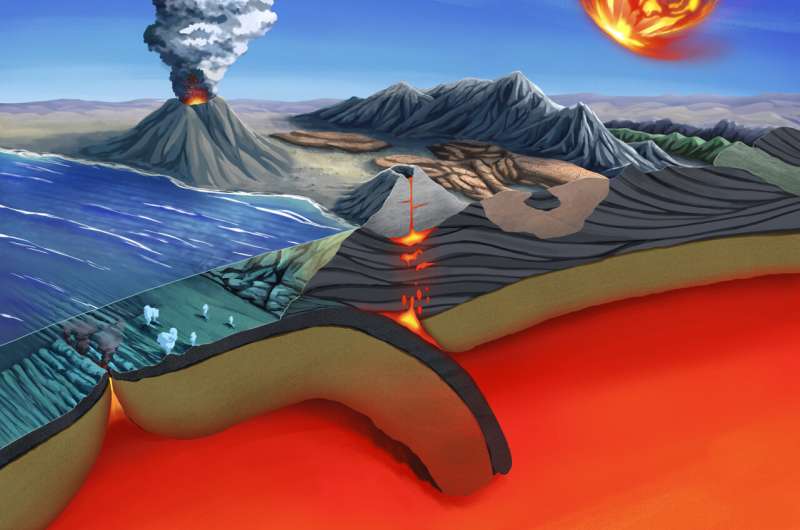Methane could be the first detectable indication of life beyond Earth

If life is abundant in the universe, atmospheric methane may be the first sign of life beyond Earth detectable by astronomers. Although nonbiological processes can generate methane, a new study by scientists at UC Santa Cruz establishes a set of circumstances in which a persuasive case could be made for biological activity as the source of methane in a rocky planet's atmosphere.
This is especially noteworthy because methane is one of the few potential signs of life, or "biosignatures," that could be readily detectable with the James Webb Space Telescope, which will begin observations later this year.
"Oxygen is often talked about as one of the best biosignatures, but it's probably going to be hard to detect with JWST," said Maggie Thompson, a graduate student in astronomy and astrophysics at UC Santa Cruz and lead author of the new study.
Despite some prior studies on methane biosignatures, there had not been an up-to-date, dedicated assessment of the planetary conditions needed for methane to be a good biosignature. "We wanted to provide a framework for interpreting observations, so if we see a rocky planet with methane, we know what other observations are needed for it to be a persuasive biosignature," Thompson said.
Published March 28 in Proceedings of the National Academy of Sciences, the study examines a variety of non-biological sources of methane and assesses their potential to maintain a methane-rich atmosphere. These include volcanoes; reactions in settings such as mid-ocean ridges, hydrothermal vents, and tectonic subduction zones; and comet or asteroid impacts.
The case for methane as a biosignature stems from its instability in the atmosphere. Because photochemical reactions destroy atmospheric methane, it must be steadily replenished to maintain high levels.
"If you detect a lot of methane on a rocky planet, you typically need a massive source to explain that," said coauthor Joshua Krissansen-Totton, a Sagan Fellow at UCSC. "We know biological activity creates large amounts of methane on Earth, and probably did on the early Earth as well because making methane is a fairly easy thing to do metabolically."
Nonbiological sources, however, would not be able to produce that much methane without also generating observable clues to its origins. Outgassing from volcanoes, for example, would add both methane and carbon monoxide to the atmosphere, while biological activity tends to readily consume carbon monoxide. The researchers found that nonbiological processes cannot easily produce habitable planet atmospheres rich in both methane and carbon dioxide and with little to no carbon monoxide.
The study emphasizes the need to consider the full planetary context in evaluating potential biosignatures. The researchers concluded that, for a rocky planet orbiting a sun-like star, atmospheric methane is more likely to be considered a strong indication of life if the atmosphere also has carbon dioxide, methane is more abundant than carbon monoxide, and extremely water-rich planetary compositions can be ruled out.
"One molecule is not going to give you the answer—you have to take into account the planet's full context," Thompson said. "Methane is one piece of the puzzle, but to determine if there is life on a planet you have to consider its geochemistry, how it's interacting with its star, and the many processes that can affect a planet's atmosphere on geologic timescales."
The study considers a variety of possibilities for "false positives" and provides guidelines for assessing methane biosignatures.
"There are two things that could go wrong—you could misinterpret something as a biosignature and get a false positive, or you could overlook something that's a real biosignature," Krissansen-Totton said. "With this paper, we wanted to develop a framework to help avoid both of those potential errors with methane."
He added that there is still a lot of work to be done to fully understand any future methane detections. "This study is focused on the most obvious false positives for methane as a biosignature," he said. "The atmospheres of rocky exoplanets are probably going to surprise us, and we will need to be cautious in our interpretations. Future work should try to anticipate and quantify more unusual mechanisms for nonbiological methane production."
In addition to Thompson and Krissansen-Totton, the coauthors of the paper include Jonathan Fortney, professor of astronomy and astrophysics at UCSC, Myriam Telus, assistant professor of Earth and planetary sciences at UCSC, and Nicholas Wogan at the University of Washington, Seattle.
More information: The case and context for atmospheric methane as an exoplanet biosignature, Proceedings of the National Academy of Sciences (2022). DOI: 10.1073/pnas.2117933119
Journal information: Proceedings of the National Academy of Sciences
Provided by University of California - Santa Cruz





















